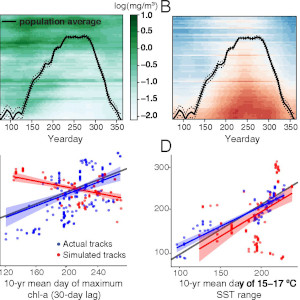In terrestrial systems, the green wave hypothesis posits that migrating animals can enhance foraging opportunities by tracking phenological variation in high-quality forage across space (i.e., “resource waves”). To track resource waves, animals may rely on proximate cues and/or memory of long-term average phenologies. Although there is growing evidence of resource tracking in terrestrial migrants, such drivers remain unevaluated in migratory marine megafauna. Here we present a test of the green wave hypothesis in a marine system. We compare 10 years of blue whale movement data with the timing of the spring phytoplankton bloom resulting in increased prey availability in the California Current Ecosystem, allowing us to investigate resource tracking both contemporaneously (response to proximate cues) and based on climatological conditions (memory) during migrations. Blue whales closely tracked the long-term average phenology of the spring bloom, but did not track contemporaneous green-up. In addition, blue whale foraging locations were characterized by low long-term habitat variability and high long-term productivity compared with contemporaneous measurements. Results indicate that memory of long-term average conditions may have a previously underappreciated role in driving migratory movements of long-lived species in marine systems, and suggest that these animals may struggle to respond to rapid deviations from historical mean environmental conditions. Results further highlight that an ecological theory of migration is conserved across marine and terrestrial systems. Understanding the drivers of animal migration is critical for assessing how environmental changes will affect highly mobile fauna at a global scale.
Memory and resource tracking drive blue whale migrations
Publication date
February 25, 2019
Abstract
Journal
Proceedings of the National Academy of Sciences
Region
California Current


